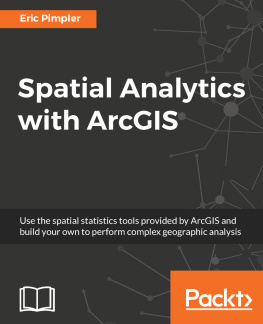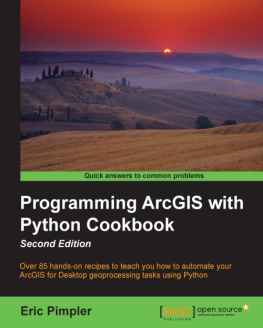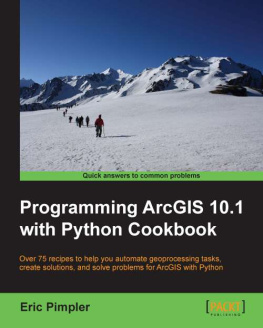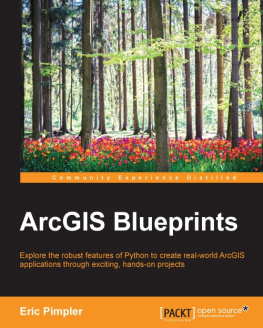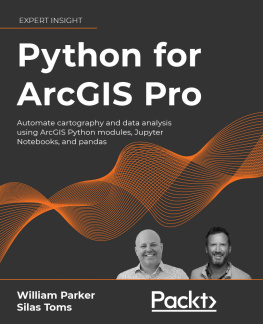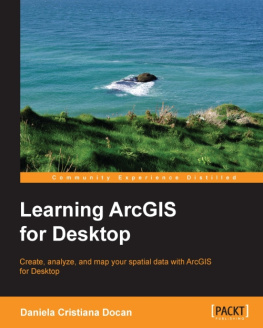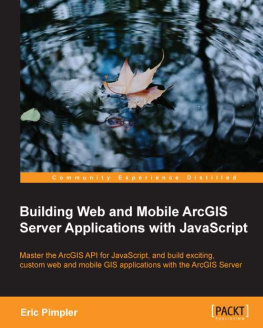
Title Page
Spatial Analytics with ArcGIS
Use the spatial statistics tools provided by ArcGIS and build your own to perform complex geographic analysis
Eric Pimpler
BIRMINGHAM - MUMBAI
Copyright
Spatial Analytics with ArcGIS
Copyright 2017 Packt Publishing
All rights reserved. No part of this book may be reproduced, stored in a retrieval system, or transmitted in any form or by any means, without the prior written permission of the publisher, except in the case of brief quotations embedded in critical articles or reviews.
Every effort has been made in the preparation of this book to ensure the accuracy of the information presented. However, the information contained in this book is sold without warranty, either express or implied. Neither the author, nor Packt Publishing, and its dealers and distributors will be held liable for any damages caused or alleged to be caused directly or indirectly by this book.
Packt Publishing has endeavored to provide trademark information about all of the companies and products mentioned in this book by the appropriate use of capitals. However, Packt Publishing cannot guarantee the accuracy of this information.
First published: April 2017
Production reference: 1200417
Published by Packt Publishing Ltd.
Livery Place
35 Livery Street
Birmingham
B3 2PB, UK.
ISBN 978-1-78712-258-1
www.packtpub.com
Credits
Author Eric Pimpler | Copy Editor Pranjali Chury |
Reviewer Ken Doman | Project Coordinator Vaidehi Sawant |
Commissioning Editor Aaron Lazar | Proofreader Safis Editing |
Acquisition Editor Vinay Argekar | Indexer Mariammal Chettiyar |
ContentDevelopmentEditor Zeeyan Pinheiro | Graphics Abhinash Sahu |
Technical Editor Vibhuti Gawde | Production Coordinator Aparna Bhagat |
About the Author
Eric Pimpler is the founder and owner of GeoSpatial Training Services (geospatialtraining.com) and has over 20 years of, experience implementing and teaching GIS solutions using open source technology, ESRI and Google Earth/Maps. Currently, he focuses on ArcGIS scripting with Python and the development of custom ArcGIS Server web and mobile applications using JavaScript.
Eric has a bachelors degree in geography from Texas A&M University and a master's degree in applied geography with a concentration in GIS from Texas State University.
Eric is the author of Programming ArcGIS with Python Cookbook (https://www.packtpub.com/application-development/programming-arcgis-python-cookbook-second-edition), first and second edition, Building Web (https://www.packtpub.com/application-development/building-web-and-mobile-arcgis-server-applications-javascript) and Mobile ArcGIS Server Applications with JavaScript, and ArcGIS Blueprints (https://www.packtpub.com/application-development/arcgis-blueprints), all by Packt Publishing.
About the Reviewer
Ken Doman is a senior frontend engineer at GEO Jobe, a software development company and ESRI business partner that helps public sector organizations and private sector businesses get the most out of geospatial solutions. Ken has worked with web and geospatial solutions for local and county government, and private industry for over 9 years.
Ken is the author of Mastering ArcGIS Server Development with JavaScript. He has also reviewed several books for Packt Publishing, including Building Web and Mobile ArcGIS Server Applications with JavaScript by Eric Pimpler and ArcGIS for Desktop Cookbook by Daniela Christiana Docan.
I'd like to thank my wife for putting up with the late nights while I reviewed books and videos. I would also like to thank GEO Jobe and all my previous employers, Bruce Harris and Associates, City of Plantation, Florida, and the City of Jacksonville, Texas. You all gave me opportunities to learn and work in a career that I enjoy. I would like to thank Packt Publishing, who found me when I was a simple blogger and social media junkie, and let me have a place to make a positive impact in GIS. Finally, I would like to thank the one from whom all blessings flow.
www.PacktPub.com
For support files and downloads related to your book, please visit www.PacktPub.com .
Did you know that Packt offers eBook versions of every book published, with PDF and ePub files available? You can upgrade to the eBook version at www.PacktPub.com and as a print book customer, you are entitled to a discount on the eBook copy. Get in touch with us at service@packtpub.com for more details.
At www.PacktPub.com , you can also read a collection of free technical articles, sign up for a range of free newsletters and receive exclusive discounts and offers on Packt books and eBooks.

https://www.packtpub.com/mapt
Get the most in-demand software skills with Mapt. Mapt gives you full access to all Packt books and video courses, as well as industry-leading tools to help you plan your personal development and advance your career.
Why subscribe?
- Fully searchable across every book published by Packt
- Copy and paste, print, and bookmark content
- On demand and accessible via a web browser
Customer Feedback
Thanks for purchasing this Packt book. At Packt, quality is at the heart of our editorial process. To help us improve, please leave us an honest review on this book's Amazon page at https://www.amazon.com/dp/1787122581.
If you'd like to join our team of regular reviewers, you can e-mail us at customerreviews@packtpub.com. We award our regular reviewers with free eBooks and videos in exchange for their valuable feedback. Help us be relentless in improving our products!
Preface
The Spatial Statistics toolbox in ArcGIS contains a set of tools for analyzing spatial distributions, patterns, processes, and relationships. While similar to traditional statistics, spatial statistics are a unique set of analyses that incorporate geography. These tools can be used with all license levels of ArcGIS Desktop and are a unique way of exploring the spatial relationships inherent in your data. In addition to using ArcBridge, the R programming language can now be used with ArcGIS Desktop to provide customized statistical analysis and tools.
Spatial Analytics in ArcGIS begins with an introduction to the field of spatial statistics. After this brief introduction ,well examine increasingly complex spatial statistics tools. Well start by covering the tools found in the Measuring Geographic Distributions toolset, which provide descriptive spatial statistical information. Next, the Analyzing Patterns toolset will teach the reader how to evaluate datasets for clustering, dispersion, or random patterns. As we move on, you will also be introduced to much more advanced and interesting spatial statistical analysis, including hot spot analysis, similarity search, and least squares regression among others.
Next page
